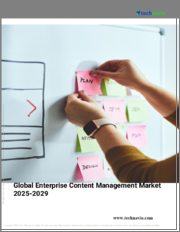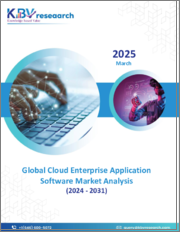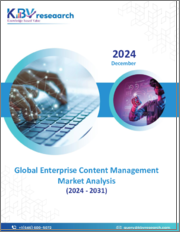
|
시장보고서
상품코드
1701823
클라우드 기업 애플리케이션 소프트웨어 시장 보고서 : 솔루션별, 업종별, 지역별(2025-2033년)Cloud Enterprise Application Software Market Report by Solution, Industry Vertical, and Region 2025-2033 |
||||||
세계의 클라우드 기업 애플리케이션 소프트웨어 시장 규모는 2024년에 1,721억 달러에 달했습니다. 향후 IMARC Group은 2033년에는 4,626억 달러에 달하며, 2025-2033년의 성장률(CAGR)은 11.03%에 달할 것으로 예측하고 있습니다. 기업 용도를 지원하는 확장성과 유연성이 높은 소프트웨어 솔루션에 대한 요구가 증가하면서 시장을 자극하고 있습니다.
클라우드 기업 용도 소프트웨어(EAS)는 조직이 생산성과 효율성을 높여 다양한 업무를 수행하기 위해 통합하는 고급 비즈니스 솔루션을 말합니다. 여기에는 전사적 자원관리(ERP), 공급망 관리(SCP), 영업 지원(SFA), 고객 관계 관리(CRM), 비즈니스 인텔리전스(BI), 웹 회의 솔루션 등이 포함됩니다. 이러한 용도는 기업의 자산을 관리하고, 컨택센터 운영 관리(CCOM)를 지원하며, 고객과의 관계를 강화하고, 재고를 추적하고, 미래의 제품 수요를 예측할 수 있도록 돕습니다. 이 외에도 클라우드 EAS는 업무 절차의 자동화와 보고된 데이터 및 시각적 자료의 해석을 돕습니다. 결과적으로 이 솔루션은 다양한 최종사용자가 비즈니스 모순을 완화하고, 소통하고, 컨텐츠를 관리하고, 전체 워크플로우를 최적화하기 위해 다양한 최종사용자가 사용합니다.
클라우드 기업 용도 소프트웨어 시장 동향 :
클라우드 기반 컴퓨팅에 대한 수요 증가와 고객 중심주의에 대한 사용자들의 성향 변화로 인해 중소기업(SME) 전반에 걸쳐 클라우드 EAS의 보급이 확산되고 있습니다. 그 배경에는 급속한 산업화, 인터넷의 보급, 비즈니스 관리 솔루션 강화에 대한 조직의 요구가 증가하고 있습니다. 이에 따라 정보기술(IT) 인프라 비용 절감과 문서 동기화, 업데이트 및 저장을 지원하는 SaaS(Software as a Service) 클라우드 컴퓨팅 서비스 모델의 광범위한 채택이 또 다른 성장 촉진요인으로 작용하고 있습니다. 또한 복잡한 클라우드 기반 용도를 실행하고 기존 보안 컴플라이언스를 최적화하기 위해 빅데이터 분석, 보안 인터페이스, 소셜미디어 용도, 모바일 앱 개발 플랫폼이 대규모로 통합되고 있는 것도 시장 성장에 기여하고 있습니다. 성장을 가속하고 있습니다. 또한 BYOD(Bring-your-own-device) 및 WFH(Work-from-Home) 모델의 도입, 특히 COVID-19의 유행은 자산관리를 위한 하이브리드 클라우드 컴퓨팅 기업 용도의 필요성을 더욱 보완하고 있습니다. 하고 있습니다. 이와는 별도로, 주요 기업 간의 전략적 제휴를 통해 추가 기능을 갖춘 다양한 제품을 출시하고 있으며, 시장 전망을 밝게 하고 있습니다.
이 보고서에서 다룬 주요 질문
- 세계의 클라우드 기업 용도 소프트웨어 시장 규모는?
- 2025-2033년 세계 클라우드 기업 용도 소프트웨어 시장의 예상 성장률은?
- 세계 클라우드 기업 용도 소프트웨어 시장을 촉진하는 주요 요인은 무엇인가?
- COVID-19가 세계 클라우드 기업 용도 소프트웨어 시장 성장에 미치는 영향은?
- 세계 클라우드 기업 용도 소프트웨어 시장의 솔루션별 시장 현황은?
- 전 세계 클라우드 기업 용도 소프트웨어 시장의 주요 지역은?
- 세계 클라우드 기업 용도 소프트웨어 시장의 주요 기업은?
목차
제1장 서문
제2장 조사 범위와 조사 방법
- 조사의 목적
- 이해관계자
- 데이터 소스
- 1차 정보
- 2차 정보
- 시장 추정
- 보텀업 어프로치
- 톱다운 어프로치
- 조사 방법
제3장 개요
제4장 서론
- 개요
- 주요 업계 동향
제5장 세계의 클라우드 기업 애플리케이션 소프트웨어 시장
- 시장 개요
- 시장 실적
- COVID-19의 영향
- 시장 예측
제6장 시장 내역 : 솔루션별
- 고객관계관리(CRM)
- 전사적 자원 플래닝(ERP)
- 공급망 관리(SCM)
- 웹 회의
- 비즈니스 인텔리전스(BI)
- 비즈니스 프로세스 관리(BPM)
- 컨텐츠 관리 시스템(CMS)
- 기업 자산관리(EAM)
- 기타
제7장 시장 내역 : 업종별
- 제조업과 서비스업
- 은행, 금융 서비스, 보험(BFSI)
- 헬스케어
- 소매
- 정부
- 석유 및 가스
- 통신
- 기타
제8장 시장 내역 : 지역별
- 북미
- 미국
- 캐나다
- 아시아태평양
- 중국
- 일본
- 인도
- 한국
- 호주
- 인도네시아
- 기타
- 유럽
- 독일
- 프랑스
- 영국
- 이탈리아
- 스페인
- 러시아
- 기타
- 라틴아메리카
- 브라질
- 멕시코
- 기타
- 중동 및 아프리카
- 시장 내역 : 국가별
제9장 SWOT 분석
- 개요
- 강점
- 약점
- 기회
- 위협
제10장 밸류체인 분석
제11장 Porter's Five Forces 분석
- 개요
- 바이어의 교섭력
- 공급 기업의 교섭력
- 경쟁의 정도
- 신규 진출업체의 위협
- 대체품의 위협
제12장 가격 분석
제13장 경쟁 구도
- 시장 구조
- 주요 기업
- 주요 기업의 개요
- Accruent LLC(Fortive Corporation)
- Epicor Software Corporation
- Hewlett Packard Enterprise Development LP
- IFS AB
- Infor Inc.(Koch Industries Inc.)
- International Business Machines Corporation
- Microsoft Corporation
- Oracle Corporation
- QAC Inc.
- Salesforce Inc.
- SAP SE
The global cloud enterprise application software market size reached USD 172.1 Billion in 2024. Looking forward, IMARC Group expects the market to reach USD 462.6 Billion by 2033, exhibiting a growth rate (CAGR) of 11.03% during 2025-2033. The rising need for scalable and flexible software solutions to support enterprise applications is stimulating the market.
Cloud enterprise application software (EAS) refers to advanced business solutions that organizations integrate to perform various operations with enhanced productivity and efficiency. It involves enterprise resource planning (ERP), supply chain management (SCP), sales force automation (SFA), customer relationship management (CRM), business intelligence (BI), and web conferencing solutions. These applications manage enterprise assets, help with contact center operations management (CCOM), enhance customer relations, track inventory, and predict future product demand. Apart from this, cloud EAS aids in automating business procedures and interpreting reported data and visuals. Consequently, the solution is used by various end-users to mitigate business inconsistencies, communicate, manage content, and optimize the overall workflow.
Cloud Enterprise Application Software Market Trends:
The increasing demand for cloud-based computing and the shifting user inclination toward a customer-centric approach have facilitated the widespread adoption of cloud EAS across small and medium-sized enterprises (SMEs). This can be further attributed to rapid industrialization, escalating internet penetration, and the growing organizational need for enhanced business management solutions. In line with this, the extensive adoption of software as a service (SaaS) cloud computing service model that helps reduce information technology (IT) infrastructural costs and synchronizes, updates, and stores documents, is acting as another growth-inducing factor. Additionally, the large-scale integration of big data analytics, security interface, social media applications, and mobile app development platforms to perform complex cloud-based applications and optimize existing security compliances are impelling the market growth. Moreover, the implementation of bring-your-own-device (BYOD) and work-from-home (WFH) models, especially during the COVID-19 pandemic, has further supplemented the need for hybrid cloud computing enterprise applications for asset management. Apart from this, strategic collaborations amongst key players to launch product variants with additional features are creating a positive outlook for the market.
Key Market Segmentation:
Breakup by Solution:
- Customer Relationship Management (CRM)
- Enterprise Resource Planning (ERP)
- Supply Chain Management (SCM)
- Web Conferencing
- Business Intelligence (BI)
- Business Process Management (BPM)
- Content Management System (CMS)
- Enterprise Asset Management (EAM)
- Others
Breakup by Industry Vertical:
- Manufacturing and Services
- Banking, Financial Services and Insurance (BFSI)
- Healthcare
- Retail
- Government
- Oil and Gas
- Telecom
- Others
Breakup by Region:
- North America
- United States
- Canada
- Asia-Pacific
- China
- Japan
- India
- South Korea
- Australia
- Indonesia
- Others
- Europe
- Germany
- France
- United Kingdom
- Italy
- Spain
- Russia
- Others
- Latin America
- Brazil
- Mexico
- Others
- Middle East and Africa
Competitive Landscape:
The competitive landscape of the industry has also been examined along with the profiles of the key players being Accruent LLC (Fortive Corporation), Epicor Software Corporation, Hewlett Packard Enterprise Development LP, IFS AB, Infor Inc. (Koch Industries Inc.), International Business Machines Corporation, Microsoft Corporation, Oracle Corporation, QAC Inc., Salesforce Inc. and SAP SE.
Key Questions Answered in This Report
- 1.How big is the global cloud enterprise application software market?
- 2.What is the expected growth rate of the global cloud enterprise application software market during 2025-2033?
- 3.What are the key factors driving the global cloud enterprise application software market?
- 4.What has been the impact of COVID-19 on the global cloud enterprise application software market growth?
- 5.What is the breakup of the global cloud enterprise application software market based on the solution?
- 6.What are the key regions in the global cloud enterprise application software market?
- 7.Who are the key players/companies in the global cloud enterprise application software market?
Table of Contents
1 Preface
2 Scope and Methodology
- 2.1 Objectives of the Study
- 2.2 Stakeholders
- 2.3 Data Sources
- 2.3.1 Primary Sources
- 2.3.2 Secondary Sources
- 2.4 Market Estimation
- 2.4.1 Bottom-Up Approach
- 2.4.2 Top-Down Approach
- 2.5 Forecasting Methodology
3 Executive Summary
4 Introduction
- 4.1 Overview
- 4.2 Key Industry Trends
5 Global Cloud Enterprise Application Software Market
- 5.1 Market Overview
- 5.2 Market Performance
- 5.3 Impact of COVID-19
- 5.4 Market Forecast
6 Market Breakup by Solution
- 6.1 Customer Relationship Management (CRM)
- 6.1.1 Market Trends
- 6.1.2 Market Forecast
- 6.2 Enterprise Resource Planning (ERP)
- 6.2.1 Market Trends
- 6.2.2 Market Forecast
- 6.3 Supply Chain Management (SCM)
- 6.3.1 Market Trends
- 6.3.2 Market Forecast
- 6.4 Web Conferencing
- 6.4.1 Market Trends
- 6.4.2 Market Forecast
- 6.5 Business Intelligence (BI)
- 6.5.1 Market Trends
- 6.5.2 Market Forecast
- 6.6 Business Process Management (BPM)
- 6.6.1 Market Trends
- 6.6.2 Market Forecast
- 6.7 Content Management System (CMS)
- 6.7.1 Market Trends
- 6.7.2 Market Forecast
- 6.8 Enterprise Asset Management (EAM)
- 6.8.1 Market Trends
- 6.8.2 Market Forecast
- 6.9 Others
- 6.9.1 Market Trends
- 6.9.2 Market Forecast
7 Market Breakup by Industry Vertical
- 7.1 Manufacturing and Services
- 7.1.1 Market Trends
- 7.1.2 Market Forecast
- 7.2 Banking, Financial Services and Insurance (BFSI)
- 7.2.1 Market Trends
- 7.2.2 Market Forecast
- 7.3 Healthcare
- 7.3.1 Market Trends
- 7.3.2 Market Forecast
- 7.4 Retail
- 7.4.1 Market Trends
- 7.4.2 Market Forecast
- 7.5 Government
- 7.5.1 Market Trends
- 7.5.2 Market Forecast
- 7.6 Oil and Gas
- 7.6.1 Market Trends
- 7.6.2 Market Forecast
- 7.7 Telecom
- 7.7.1 Market Trends
- 7.7.2 Market Forecast
- 7.8 Others
- 7.8.1 Market Trends
- 7.8.2 Market Forecast
8 Market Breakup by Region
- 8.1 North America
- 8.1.1 United States
- 8.1.1.1 Market Trends
- 8.1.1.2 Market Forecast
- 8.1.2 Canada
- 8.1.2.1 Market Trends
- 8.1.2.2 Market Forecast
- 8.1.1 United States
- 8.2 Asia-Pacific
- 8.2.1 China
- 8.2.1.1 Market Trends
- 8.2.1.2 Market Forecast
- 8.2.2 Japan
- 8.2.2.1 Market Trends
- 8.2.2.2 Market Forecast
- 8.2.3 India
- 8.2.3.1 Market Trends
- 8.2.3.2 Market Forecast
- 8.2.4 South Korea
- 8.2.4.1 Market Trends
- 8.2.4.2 Market Forecast
- 8.2.5 Australia
- 8.2.5.1 Market Trends
- 8.2.5.2 Market Forecast
- 8.2.6 Indonesia
- 8.2.6.1 Market Trends
- 8.2.6.2 Market Forecast
- 8.2.7 Others
- 8.2.7.1 Market Trends
- 8.2.7.2 Market Forecast
- 8.2.1 China
- 8.3 Europe
- 8.3.1 Germany
- 8.3.1.1 Market Trends
- 8.3.1.2 Market Forecast
- 8.3.2 France
- 8.3.2.1 Market Trends
- 8.3.2.2 Market Forecast
- 8.3.3 United Kingdom
- 8.3.3.1 Market Trends
- 8.3.3.2 Market Forecast
- 8.3.4 Italy
- 8.3.4.1 Market Trends
- 8.3.4.2 Market Forecast
- 8.3.5 Spain
- 8.3.5.1 Market Trends
- 8.3.5.2 Market Forecast
- 8.3.6 Russia
- 8.3.6.1 Market Trends
- 8.3.6.2 Market Forecast
- 8.3.7 Others
- 8.3.7.1 Market Trends
- 8.3.7.2 Market Forecast
- 8.3.1 Germany
- 8.4 Latin America
- 8.4.1 Brazil
- 8.4.1.1 Market Trends
- 8.4.1.2 Market Forecast
- 8.4.2 Mexico
- 8.4.2.1 Market Trends
- 8.4.2.2 Market Forecast
- 8.4.3 Others
- 8.4.3.1 Market Trends
- 8.4.3.2 Market Forecast
- 8.4.1 Brazil
- 8.5 Middle East and Africa
- 8.5.1 Market Trends
- 8.5.2 Market Breakup by Country
- 8.5.3 Market Forecast
9 SWOT Analysis
- 9.1 Overview
- 9.2 Strengths
- 9.3 Weaknesses
- 9.4 Opportunities
- 9.5 Threats
10 Value Chain Analysis
11 Porters Five Forces Analysis
- 11.1 Overview
- 11.2 Bargaining Power of Buyers
- 11.3 Bargaining Power of Suppliers
- 11.4 Degree of Competition
- 11.5 Threat of New Entrants
- 11.6 Threat of Substitutes
12 Price Analysis
13 Competitive Landscape
- 13.1 Market Structure
- 13.2 Key Players
- 13.3 Profiles of Key Players
- 13.3.1 Accruent LLC (Fortive Corporation)
- 13.3.1.1 Company Overview
- 13.3.1.2 Product Portfolio
- 13.3.2 Epicor Software Corporation
- 13.3.2.1 Company Overview
- 13.3.2.2 Product Portfolio
- 13.3.2.3 SWOT Analysis
- 13.3.3 Hewlett Packard Enterprise Development LP
- 13.3.3.1 Company Overview
- 13.3.3.2 Product Portfolio
- 13.3.3.3 Financials
- 13.3.3.4 SWOT Analysis
- 13.3.4 IFS AB
- 13.3.4.1 Company Overview
- 13.3.4.2 Product Portfolio
- 13.3.5 Infor Inc. (Koch Industries Inc.)
- 13.3.5.1 Company Overview
- 13.3.5.2 Product Portfolio
- 13.3.6 International Business Machines Corporation
- 13.3.6.1 Company Overview
- 13.3.6.2 Product Portfolio
- 13.3.6.3 Financials
- 13.3.6.4 SWOT Analysis
- 13.3.7 Microsoft Corporation
- 13.3.7.1 Company Overview
- 13.3.7.2 Product Portfolio
- 13.3.7.3 Financials
- 13.3.7.4 SWOT Analysis
- 13.3.8 Oracle Corporation
- 13.3.8.1 Company Overview
- 13.3.8.2 Product Portfolio
- 13.3.8.3 Financials
- 13.3.8.4 SWOT Analysis
- 13.3.9 QAC Inc.
- 13.3.9.1 Company Overview
- 13.3.9.2 Product Portfolio
- 13.3.10 Salesforce Inc.
- 13.3.10.1 Company Overview
- 13.3.10.2 Product Portfolio
- 13.3.10.3 Financials
- 13.3.10.4 SWOT Analysis
- 13.3.11 SAP SE
- 13.3.11.1 Company Overview
- 13.3.11.2 Product Portfolio
- 13.3.11.3 Financials
- 13.3.11.4 SWOT Analysis
- 13.3.1 Accruent LLC (Fortive Corporation)



















